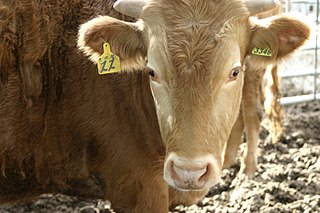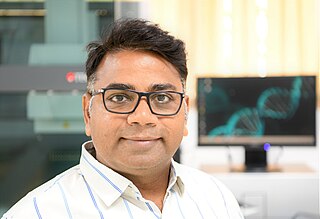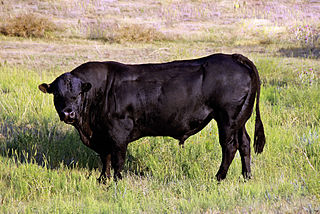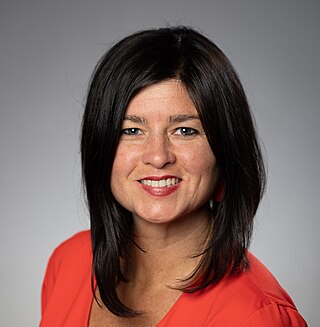
Norman Ernest Borlaug was an American agronomist who led initiatives worldwide that contributed to the extensive increases in agricultural production termed the Green Revolution. Borlaug was awarded multiple honors for his work, including the Nobel Peace Prize, the Presidential Medal of Freedom and the Congressional Gold Medal.

There are different systems of feeding cattle in animal husbandry. For pastured animals, grass is usually the forage that composes the majority of their diet. Cattle reared in feedlots are fed hay supplemented with grain, soy and other ingredients to increase the energy density of the feed. The debate is whether cattle should be raised on fodder primarily composed of grass or a concentrate. The issue is complicated by the political interests and confusion between labels such as "free range", "organic", or "natural". Cattle raised on a primarily foraged diet are termed grass-fed or pasture-raised; for example meat or milk may be called grass-fed beef or pasture-raised dairy. The term "pasture-raised" can lead to confusion with the term "free range", which does not describe exactly what the animals eat.

The Limousin, French: Limousine, is a French breed of beef cattle from the Limousin and Marche regions of France. It was formerly used mainly as a draught animal, but in modern times is reared for beef. A herd-book was established in France in 1886. With the mechanisation of agriculture in the twentieth century, numbers declined. In the 1960s there were still more than 250 000 head, but the future of the breed was not clear; it was proposed that it be merged with the other blonde draught breeds of south-western France – the Blonde des Pyrénées, the Blonde de Quercy and the Garonnaise – to form the new Blonde d'Aquitaine. Instead, a breeders' association was formed; new importance was given to extensive management, to performance recording and to exports. In the twenty-first century the Limousin is the second-most numerous beef breed in France after the Charolais. It is a world breed, raised in about eighty countries round the world, many of which have breed associations.

Genetically modified food controversies are disputes over the use of foods and other goods derived from genetically modified crops instead of conventional crops, and other uses of genetic engineering in food production. The disputes involve consumers, farmers, biotechnology companies, governmental regulators, non-governmental organizations, and scientists. The key areas of controversy related to genetically modified food are whether such food should be labeled, the role of government regulators, the objectivity of scientific research and publication, the effect of genetically modified crops on health and the environment, the effect on pesticide resistance, the impact of such crops for farmers, and the role of the crops in feeding the world population. In addition, products derived from GMO organisms play a role in the production of ethanol fuels and pharmaceuticals.
The Borlaug CAST Communication Award, formerly the Charles A. Black Award, is an annual award presented by the Council for Agricultural Science and Technology (CAST) focused on candidates who engage in promoting agriculture and agriculture-related communications.
Charles Roy Henderson was an American statistician and a pioneer in animal breeding — the application of quantitative methods for the genetic evaluation of domestic livestock. This is critically important because it allows farmers and geneticists to predict whether a crop or animal will have a desired trait, and to what extent the trait will be expressed. He developed mixed model equations to obtain best linear unbiased predictions of breeding values and, in general, any random effect. He invented three methods for the estimation of variance components in unbalanced settings of mixed models, and invented a method for constructing the inverse of Wright's numerator relationship matrix based on a simple list of pedigree information. He, with his Ph.D. student Shayle R. Searle, greatly extended the use of matrix notation in statistics. His methods are widely used by the domestic livestock industry throughout the world and are a cornerstone of linear model theory.

The Hanwoo, also Hanu or Korean Native, is a breed of small cattle native to Korea. It was formerly used as a draught animal, but this use has almost disappeared. It is now raised mainly for meat. It is one of four indigenous Korean breeds, the others being the Chikso, the Heugu and the Jeju Black.

Zilpaterol is a β2 adrenergic agonist. Under its brand name, Zilmax, it is used to increase the size of cattle and the efficiency of feeding them. Zilmax is produced by Intervet, a subsidiary of Merck & Co., and marketed as a "beef-improvement technology". Zilpaterol is typically fed in the last three to six weeks of cattle's lives, with a brief period before death for withdrawal, which allows the drug to mostly leave the animal's tissues.

Cattle or oxen are large, domesticated, bovid ungulates. They are prominent modern members of the subfamily Bovinae and the most widespread species of the genus Bos. Mature female cattle are referred to as cows and mature male cattle are referred to as bulls. Colloquially, young female cattle (heifers), young male cattle (bullocks), and castrated male cattle (steers) are also referred to as "cows".

The Romosinuano is a breed of cattle native to Colombia. Its name derives from the fact that the breed is polled (romo) and that it originated from the Sinú River valley (sinuano). Romosinunao are a criollo type, developed from the horned Costeño con Cuernos breed of Spanish origin. It is unclear whether the polled nature of the Romosinuano was due to natural mutation or to cross-breeding with European types such as the Angus or Red Poll.

Rajeev Kumar Varshney is an Indian agricultural scientist, specializing in genomics, genetics, molecular breeding and capacity building in developing countries. Varshney is currently serving as Director, Western Australian State Agricultural Biotechnology Center; Director, Centre for Crop & Food Innovation; and International Chair in Agriculture & Food Security with the Food Futures Institute at Murdoch University, Australia since Feb 2022. Before joining Murdoch University, Australia he served International Crops Research Institute for the Semi-Arid Tropics (ICRISAT), a global agriculture R&D institute, for more than 16 years in different scientific and research leadership roles including Research Program Director for three global research programs– Grain Legumes, Genetic Gains and Accelerated Crop Improvement Program. He has the onus of establishing and nurturing the Center of Excellence in Genomics & Systems Biology (CEGSB), a globally recognized center for genomics research at ICRISAT that made impacts on improving agriculture and development of human resources in several countries including India, China, Kenya, Ethiopia, Tanzania, Nigeria, Ghana, Mali, Senegal, Burkina Faso, etc. Varshney holds Adjunct/Honorary/Visiting Professor positions at 10 academic institutions in Australia, China, Ghana, Hong Kong and India, including The University of Western Australia, University of Queensland, West Africa Centre for Crop Improvement, University of Hyderabad, Chaudhary Charan Singh University and Professor Jayashankar Telangana State Agricultural University.
Turano-Mongolian cattle are a group of taurine cattle that are found in Northern and Eastern Asia. They are morphologically and genetically distinct from the Near-Eastern group of taurine cattle, from which European cattle are descended; they may have been domesticated independently.
Bovine respiratory disease (BRD) is the most common and costly disease affecting beef cattle in the world. It is a complex, bacterial or viral infection that causes pneumonia in calves which can be fatal. The infection is usually a sum of three codependent factors: stress, an underlying viral infection, and a new bacterial infection. The diagnosis of the disease is complex since there are multiple possible causes.

Edward R. Hauser was an American animal scientist who served as professor and chairman of the Department of Meat and Animal Science at University of Wisconsin–Madison.

North American Piedmontese cattle are a breed of domestic beef cattle originating from an imported herd of select Italian purebred Piedmontese cattle. The foundation line of breeding stock was first imported from Italy into Canada in 1979, and into the United States in the early 1980s. Piedmontese cattle are distinguished by a unique, naturally occurring gene identified as the myostatin allele mutation, or inactive myostatin gene. Myostatin prohibits muscle growth whereas an inactive gene has the opposite effect. Purebred Piedmontese are homozygous,, which means they have two identical alleles present for this unique gene. Research indicates the presence of the myostatin allele mutation produces morphological characteristics unique to the breed, such as double-muscling, beef tenderness, reduced fat content and high yield. According to the North American Piedmontese Association (NAPA), they are the first breed registry to base animal registration requirements on the presence of this specific gene which can be easily verified by DNA testing.

Kevin M. Folta is a professor of the horticultural sciences department at the University of Florida. From 2007 to 2010 he helped lead the project to sequence the strawberry genome, and continues to research photomorphogenesis in plants and compounds responsible for flavor in strawberries. Folta has been active as a science communicator since 2002, especially relating to biotechnology. He has faced controversy over what his critics say are his industry connections. In 2017 he was elected as a fellow of the Committee for Skeptical Inquiry.
Luca Comai is an Italian plant biologist whose work has focused on trait discovery for improving agricultural crops and on developing protocols and systems for identifying new genes and mutations in plants. Through his work at Calgene, Comai was one of the first discoverers of the glyphosate resistance gene and is considered a pioneer in the field of plant biotechnology research. His research since then has focused on developing the Targeting Induced Local Lesions in Genomes (TILLING) protocol that allows for new mutations and traits to be quickly identified within a target plant species through genome and sequence analysis. He has received a number of research and teaching awards, along with being named a Fellow for the American Association for the Advancement of Science (AAAS). In 2023, he was elected to the National Academy of Sciences.

Sarah Davidson Evanega is an American researcher who works in plant sciences, a public policy influencer and a science communicator, especially relating to agricultural biotechnology. She is a professor at the Boyce Thompson Institute for Plant Research (BTI), and an adjunct professor in the School of Integrative Plant Sciences, Cornell University. She is the director of the Alliance for Science and was awarded the 2021 Borlaug CAST Communication Award.

Lubabegron is a veterinary drug used to reduce ammonia emissions from animals and their waste. Ammonia emissions are a concern in agricultural production because of detrimental effects on the environment, human health, and animal health.













